MGT200 - Essay: Examining the Pros and Cons of Servant Leadership
VerifiedAdded on 2023/05/28
|9
|2307
|225
Essay
AI Summary
This essay critically examines the servant leadership management style, evaluating its advantages and disadvantages within an organizational context. It begins by defining servant leadership and its core principles, emphasizing its focus on prioritizing employee needs and fostering a collaborative environment. The essay then delves into the pros, including increased employee ownership, motivation, and engagement, improved team relationships, and recognition of diversity. It contrasts these benefits with the cons, such as the time-intensive nature of implementation, potential for lack of authority, and the risk of limited vision. Drawing on scholarly research and theoretical frameworks, the analysis provides a balanced perspective on the applicability and effectiveness of servant leadership, concluding with recommendations for its strategic implementation to maximize its positive impact on organizational performance and employee satisfaction. The essay is well-structured, supported by academic references, and addresses the key criteria of the assignment brief, including research, analysis, conclusions, and recommendations.
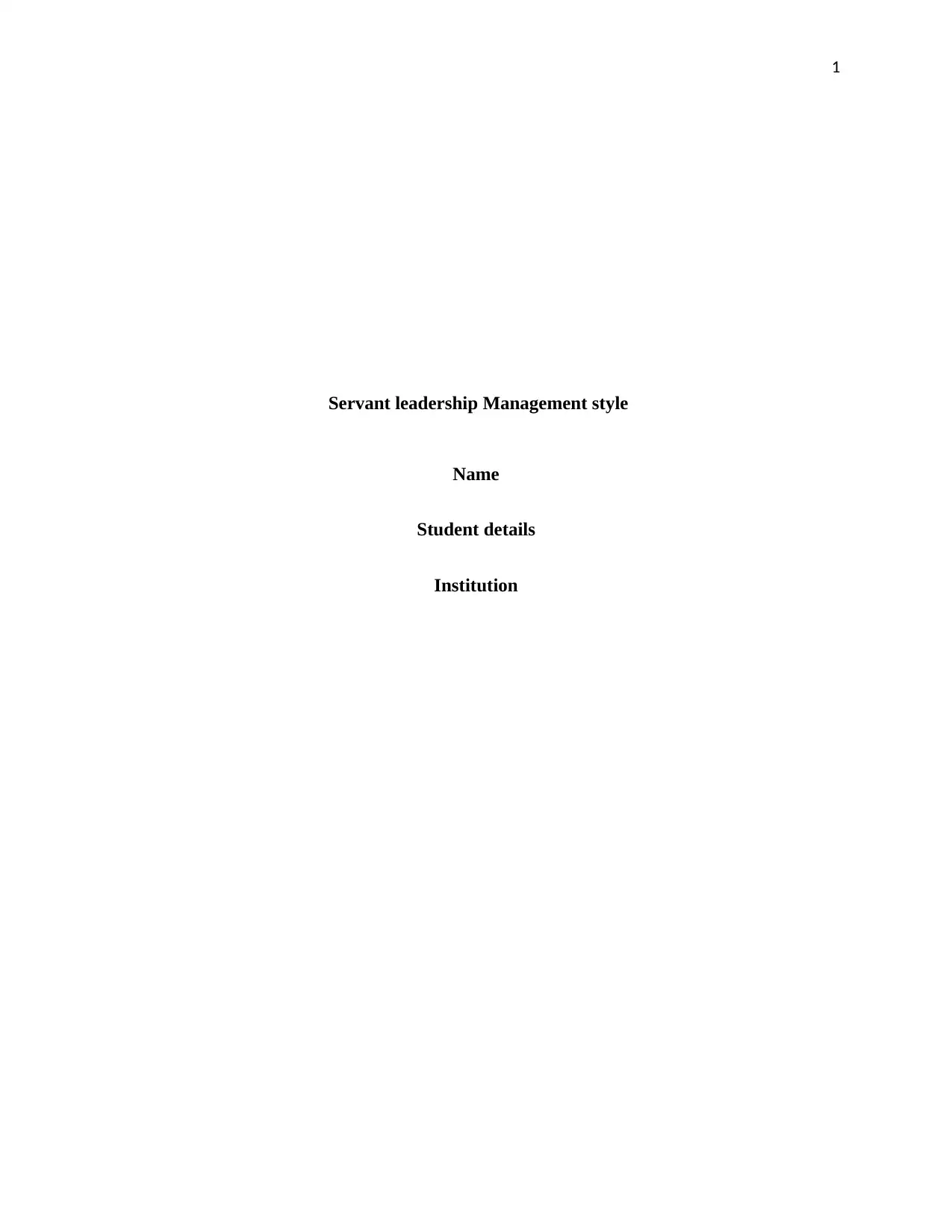
1
Servant leadership Management style
Name
Student details
Institution
Servant leadership Management style
Name
Student details
Institution
Paraphrase This Document
Need a fresh take? Get an instant paraphrase of this document with our AI Paraphraser
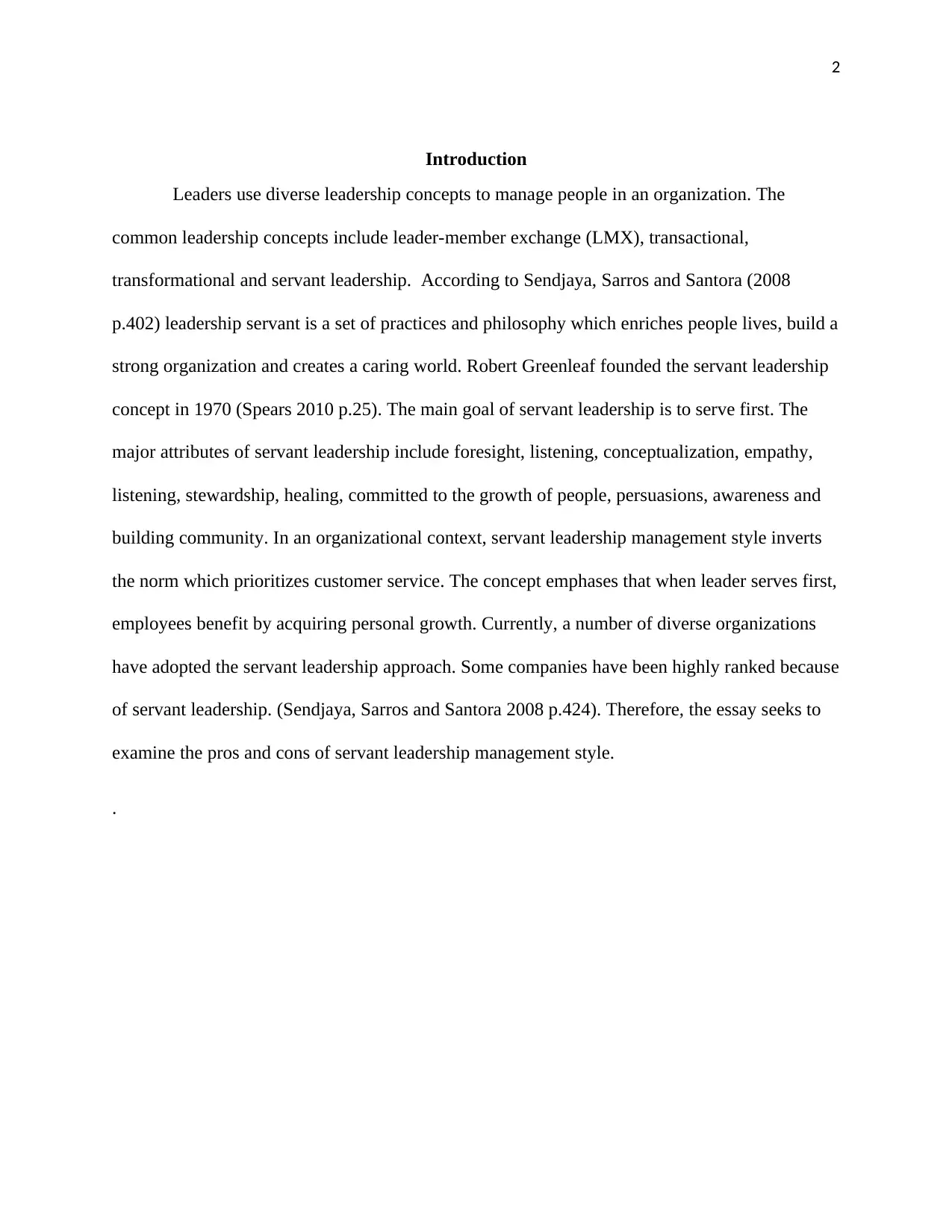
2
Introduction
Leaders use diverse leadership concepts to manage people in an organization. The
common leadership concepts include leader-member exchange (LMX), transactional,
transformational and servant leadership. According to Sendjaya, Sarros and Santora (2008
p.402) leadership servant is a set of practices and philosophy which enriches people lives, build a
strong organization and creates a caring world. Robert Greenleaf founded the servant leadership
concept in 1970 (Spears 2010 p.25). The main goal of servant leadership is to serve first. The
major attributes of servant leadership include foresight, listening, conceptualization, empathy,
listening, stewardship, healing, committed to the growth of people, persuasions, awareness and
building community. In an organizational context, servant leadership management style inverts
the norm which prioritizes customer service. The concept emphases that when leader serves first,
employees benefit by acquiring personal growth. Currently, a number of diverse organizations
have adopted the servant leadership approach. Some companies have been highly ranked because
of servant leadership. (Sendjaya, Sarros and Santora 2008 p.424). Therefore, the essay seeks to
examine the pros and cons of servant leadership management style.
.
Introduction
Leaders use diverse leadership concepts to manage people in an organization. The
common leadership concepts include leader-member exchange (LMX), transactional,
transformational and servant leadership. According to Sendjaya, Sarros and Santora (2008
p.402) leadership servant is a set of practices and philosophy which enriches people lives, build a
strong organization and creates a caring world. Robert Greenleaf founded the servant leadership
concept in 1970 (Spears 2010 p.25). The main goal of servant leadership is to serve first. The
major attributes of servant leadership include foresight, listening, conceptualization, empathy,
listening, stewardship, healing, committed to the growth of people, persuasions, awareness and
building community. In an organizational context, servant leadership management style inverts
the norm which prioritizes customer service. The concept emphases that when leader serves first,
employees benefit by acquiring personal growth. Currently, a number of diverse organizations
have adopted the servant leadership approach. Some companies have been highly ranked because
of servant leadership. (Sendjaya, Sarros and Santora 2008 p.424). Therefore, the essay seeks to
examine the pros and cons of servant leadership management style.
.
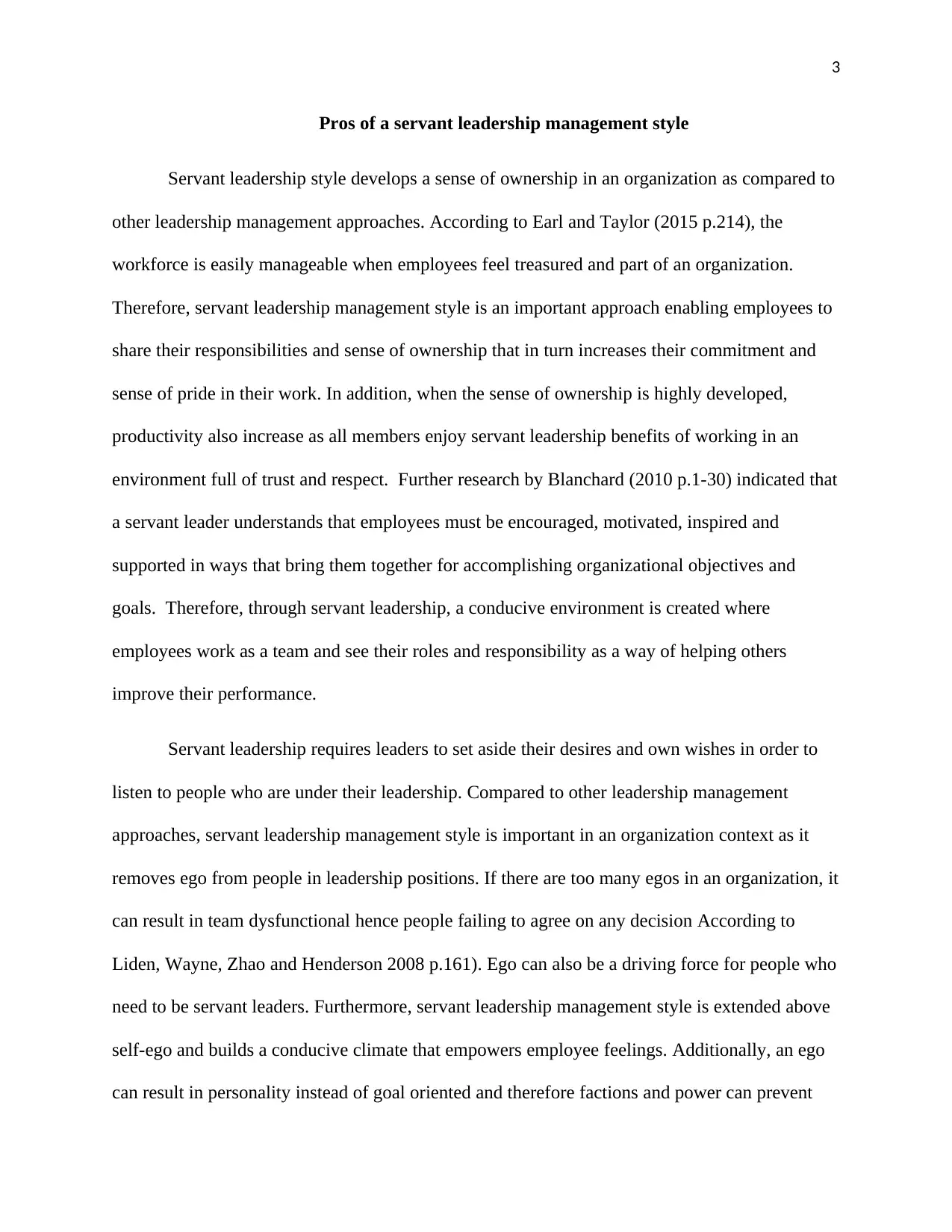
3
Pros of a servant leadership management style
Servant leadership style develops a sense of ownership in an organization as compared to
other leadership management approaches. According to Earl and Taylor (2015 p.214), the
workforce is easily manageable when employees feel treasured and part of an organization.
Therefore, servant leadership management style is an important approach enabling employees to
share their responsibilities and sense of ownership that in turn increases their commitment and
sense of pride in their work. In addition, when the sense of ownership is highly developed,
productivity also increase as all members enjoy servant leadership benefits of working in an
environment full of trust and respect. Further research by Blanchard (2010 p.1-30) indicated that
a servant leader understands that employees must be encouraged, motivated, inspired and
supported in ways that bring them together for accomplishing organizational objectives and
goals. Therefore, through servant leadership, a conducive environment is created where
employees work as a team and see their roles and responsibility as a way of helping others
improve their performance.
Servant leadership requires leaders to set aside their desires and own wishes in order to
listen to people who are under their leadership. Compared to other leadership management
approaches, servant leadership management style is important in an organization context as it
removes ego from people in leadership positions. If there are too many egos in an organization, it
can result in team dysfunctional hence people failing to agree on any decision According to
Liden, Wayne, Zhao and Henderson 2008 p.161). Ego can also be a driving force for people who
need to be servant leaders. Furthermore, servant leadership management style is extended above
self-ego and builds a conducive climate that empowers employee feelings. Additionally, an ego
can result in personality instead of goal oriented and therefore factions and power can prevent
Pros of a servant leadership management style
Servant leadership style develops a sense of ownership in an organization as compared to
other leadership management approaches. According to Earl and Taylor (2015 p.214), the
workforce is easily manageable when employees feel treasured and part of an organization.
Therefore, servant leadership management style is an important approach enabling employees to
share their responsibilities and sense of ownership that in turn increases their commitment and
sense of pride in their work. In addition, when the sense of ownership is highly developed,
productivity also increase as all members enjoy servant leadership benefits of working in an
environment full of trust and respect. Further research by Blanchard (2010 p.1-30) indicated that
a servant leader understands that employees must be encouraged, motivated, inspired and
supported in ways that bring them together for accomplishing organizational objectives and
goals. Therefore, through servant leadership, a conducive environment is created where
employees work as a team and see their roles and responsibility as a way of helping others
improve their performance.
Servant leadership requires leaders to set aside their desires and own wishes in order to
listen to people who are under their leadership. Compared to other leadership management
approaches, servant leadership management style is important in an organization context as it
removes ego from people in leadership positions. If there are too many egos in an organization, it
can result in team dysfunctional hence people failing to agree on any decision According to
Liden, Wayne, Zhao and Henderson 2008 p.161). Ego can also be a driving force for people who
need to be servant leaders. Furthermore, servant leadership management style is extended above
self-ego and builds a conducive climate that empowers employee feelings. Additionally, an ego
can result in personality instead of goal oriented and therefore factions and power can prevent
⊘ This is a preview!⊘
Do you want full access?
Subscribe today to unlock all pages.

Trusted by 1+ million students worldwide
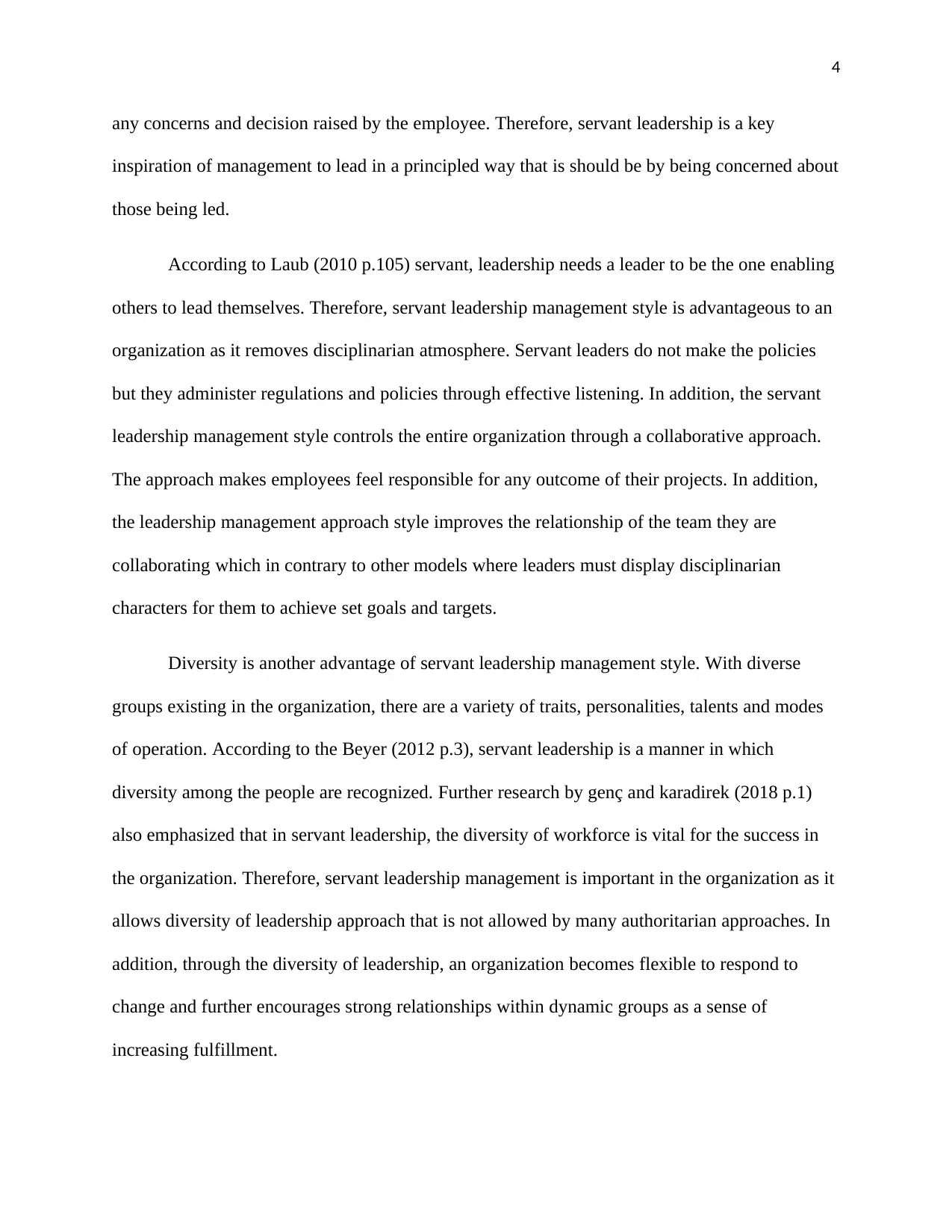
4
any concerns and decision raised by the employee. Therefore, servant leadership is a key
inspiration of management to lead in a principled way that is should be by being concerned about
those being led.
According to Laub (2010 p.105) servant, leadership needs a leader to be the one enabling
others to lead themselves. Therefore, servant leadership management style is advantageous to an
organization as it removes disciplinarian atmosphere. Servant leaders do not make the policies
but they administer regulations and policies through effective listening. In addition, the servant
leadership management style controls the entire organization through a collaborative approach.
The approach makes employees feel responsible for any outcome of their projects. In addition,
the leadership management approach style improves the relationship of the team they are
collaborating which in contrary to other models where leaders must display disciplinarian
characters for them to achieve set goals and targets.
Diversity is another advantage of servant leadership management style. With diverse
groups existing in the organization, there are a variety of traits, personalities, talents and modes
of operation. According to the Beyer (2012 p.3), servant leadership is a manner in which
diversity among the people are recognized. Further research by genç and karadirek (2018 p.1)
also emphasized that in servant leadership, the diversity of workforce is vital for the success in
the organization. Therefore, servant leadership management is important in the organization as it
allows diversity of leadership approach that is not allowed by many authoritarian approaches. In
addition, through the diversity of leadership, an organization becomes flexible to respond to
change and further encourages strong relationships within dynamic groups as a sense of
increasing fulfillment.
any concerns and decision raised by the employee. Therefore, servant leadership is a key
inspiration of management to lead in a principled way that is should be by being concerned about
those being led.
According to Laub (2010 p.105) servant, leadership needs a leader to be the one enabling
others to lead themselves. Therefore, servant leadership management style is advantageous to an
organization as it removes disciplinarian atmosphere. Servant leaders do not make the policies
but they administer regulations and policies through effective listening. In addition, the servant
leadership management style controls the entire organization through a collaborative approach.
The approach makes employees feel responsible for any outcome of their projects. In addition,
the leadership management approach style improves the relationship of the team they are
collaborating which in contrary to other models where leaders must display disciplinarian
characters for them to achieve set goals and targets.
Diversity is another advantage of servant leadership management style. With diverse
groups existing in the organization, there are a variety of traits, personalities, talents and modes
of operation. According to the Beyer (2012 p.3), servant leadership is a manner in which
diversity among the people are recognized. Further research by genç and karadirek (2018 p.1)
also emphasized that in servant leadership, the diversity of workforce is vital for the success in
the organization. Therefore, servant leadership management is important in the organization as it
allows diversity of leadership approach that is not allowed by many authoritarian approaches. In
addition, through the diversity of leadership, an organization becomes flexible to respond to
change and further encourages strong relationships within dynamic groups as a sense of
increasing fulfillment.
Paraphrase This Document
Need a fresh take? Get an instant paraphrase of this document with our AI Paraphraser
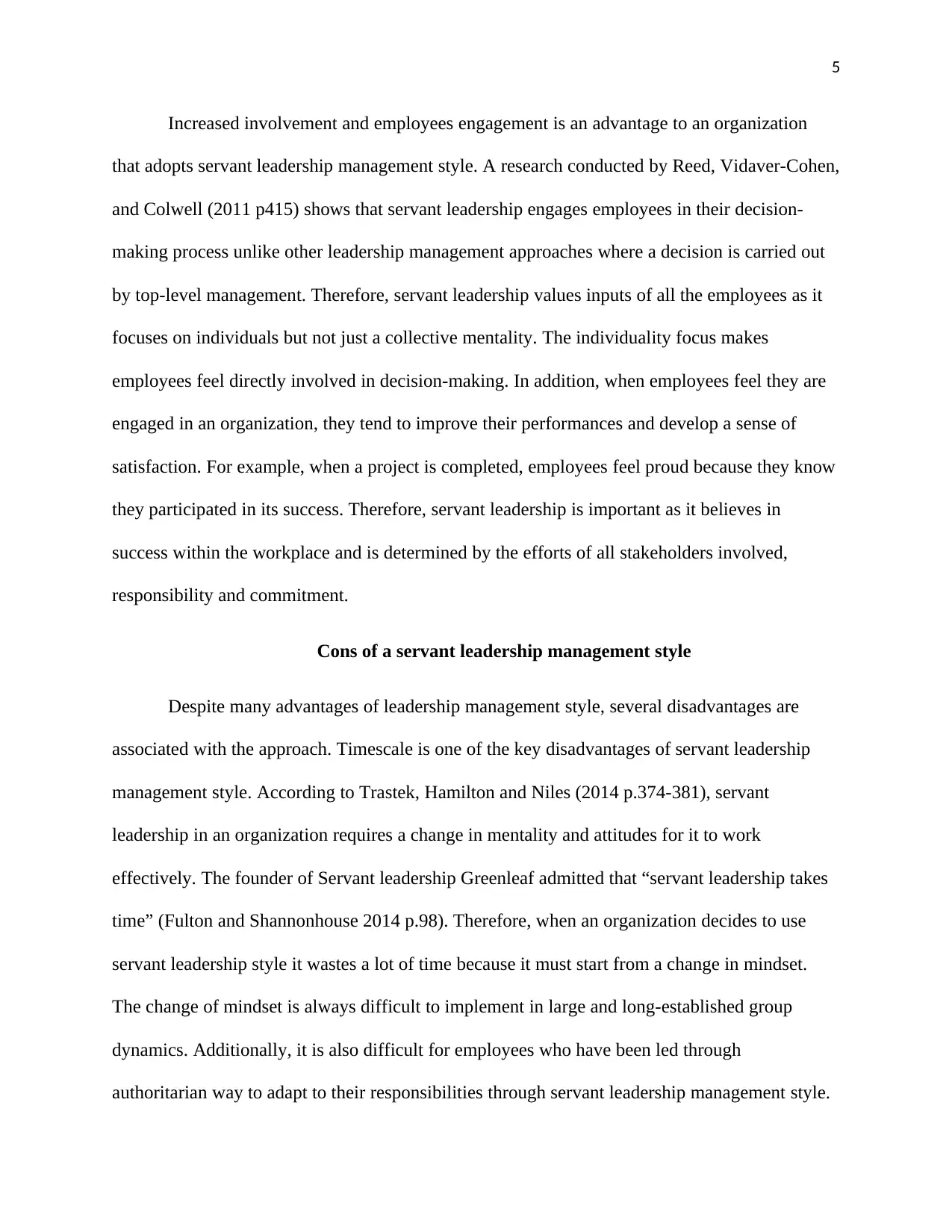
5
Increased involvement and employees engagement is an advantage to an organization
that adopts servant leadership management style. A research conducted by Reed, Vidaver-Cohen,
and Colwell (2011 p415) shows that servant leadership engages employees in their decision-
making process unlike other leadership management approaches where a decision is carried out
by top-level management. Therefore, servant leadership values inputs of all the employees as it
focuses on individuals but not just a collective mentality. The individuality focus makes
employees feel directly involved in decision-making. In addition, when employees feel they are
engaged in an organization, they tend to improve their performances and develop a sense of
satisfaction. For example, when a project is completed, employees feel proud because they know
they participated in its success. Therefore, servant leadership is important as it believes in
success within the workplace and is determined by the efforts of all stakeholders involved,
responsibility and commitment.
Cons of a servant leadership management style
Despite many advantages of leadership management style, several disadvantages are
associated with the approach. Timescale is one of the key disadvantages of servant leadership
management style. According to Trastek, Hamilton and Niles (2014 p.374-381), servant
leadership in an organization requires a change in mentality and attitudes for it to work
effectively. The founder of Servant leadership Greenleaf admitted that “servant leadership takes
time” (Fulton and Shannonhouse 2014 p.98). Therefore, when an organization decides to use
servant leadership style it wastes a lot of time because it must start from a change in mindset.
The change of mindset is always difficult to implement in large and long-established group
dynamics. Additionally, it is also difficult for employees who have been led through
authoritarian way to adapt to their responsibilities through servant leadership management style.
Increased involvement and employees engagement is an advantage to an organization
that adopts servant leadership management style. A research conducted by Reed, Vidaver-Cohen,
and Colwell (2011 p415) shows that servant leadership engages employees in their decision-
making process unlike other leadership management approaches where a decision is carried out
by top-level management. Therefore, servant leadership values inputs of all the employees as it
focuses on individuals but not just a collective mentality. The individuality focus makes
employees feel directly involved in decision-making. In addition, when employees feel they are
engaged in an organization, they tend to improve their performances and develop a sense of
satisfaction. For example, when a project is completed, employees feel proud because they know
they participated in its success. Therefore, servant leadership is important as it believes in
success within the workplace and is determined by the efforts of all stakeholders involved,
responsibility and commitment.
Cons of a servant leadership management style
Despite many advantages of leadership management style, several disadvantages are
associated with the approach. Timescale is one of the key disadvantages of servant leadership
management style. According to Trastek, Hamilton and Niles (2014 p.374-381), servant
leadership in an organization requires a change in mentality and attitudes for it to work
effectively. The founder of Servant leadership Greenleaf admitted that “servant leadership takes
time” (Fulton and Shannonhouse 2014 p.98). Therefore, when an organization decides to use
servant leadership style it wastes a lot of time because it must start from a change in mindset.
The change of mindset is always difficult to implement in large and long-established group
dynamics. Additionally, it is also difficult for employees who have been led through
authoritarian way to adapt to their responsibilities through servant leadership management style.
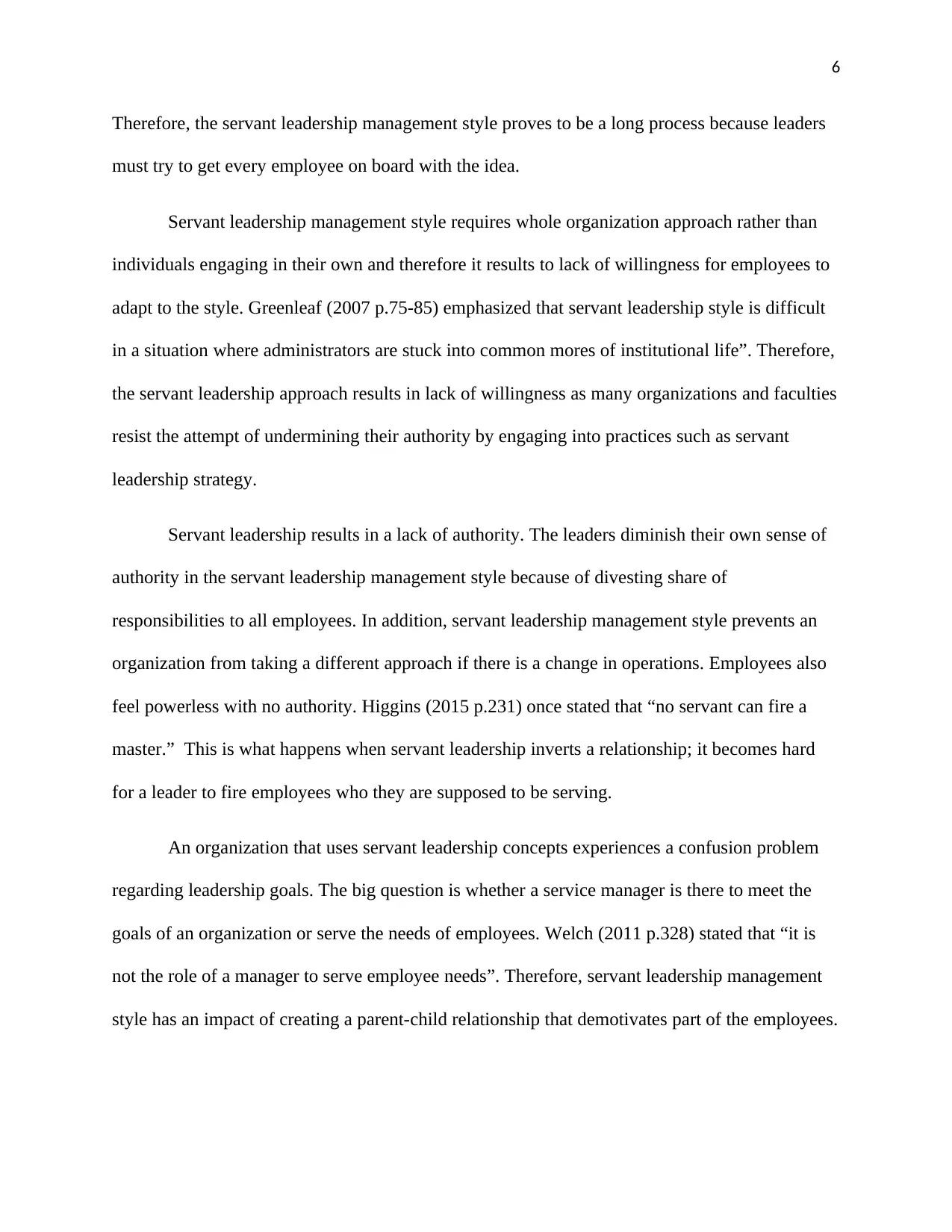
6
Therefore, the servant leadership management style proves to be a long process because leaders
must try to get every employee on board with the idea.
Servant leadership management style requires whole organization approach rather than
individuals engaging in their own and therefore it results to lack of willingness for employees to
adapt to the style. Greenleaf (2007 p.75-85) emphasized that servant leadership style is difficult
in a situation where administrators are stuck into common mores of institutional life”. Therefore,
the servant leadership approach results in lack of willingness as many organizations and faculties
resist the attempt of undermining their authority by engaging into practices such as servant
leadership strategy.
Servant leadership results in a lack of authority. The leaders diminish their own sense of
authority in the servant leadership management style because of divesting share of
responsibilities to all employees. In addition, servant leadership management style prevents an
organization from taking a different approach if there is a change in operations. Employees also
feel powerless with no authority. Higgins (2015 p.231) once stated that “no servant can fire a
master.” This is what happens when servant leadership inverts a relationship; it becomes hard
for a leader to fire employees who they are supposed to be serving.
An organization that uses servant leadership concepts experiences a confusion problem
regarding leadership goals. The big question is whether a service manager is there to meet the
goals of an organization or serve the needs of employees. Welch (2011 p.328) stated that “it is
not the role of a manager to serve employee needs”. Therefore, servant leadership management
style has an impact of creating a parent-child relationship that demotivates part of the employees.
Therefore, the servant leadership management style proves to be a long process because leaders
must try to get every employee on board with the idea.
Servant leadership management style requires whole organization approach rather than
individuals engaging in their own and therefore it results to lack of willingness for employees to
adapt to the style. Greenleaf (2007 p.75-85) emphasized that servant leadership style is difficult
in a situation where administrators are stuck into common mores of institutional life”. Therefore,
the servant leadership approach results in lack of willingness as many organizations and faculties
resist the attempt of undermining their authority by engaging into practices such as servant
leadership strategy.
Servant leadership results in a lack of authority. The leaders diminish their own sense of
authority in the servant leadership management style because of divesting share of
responsibilities to all employees. In addition, servant leadership management style prevents an
organization from taking a different approach if there is a change in operations. Employees also
feel powerless with no authority. Higgins (2015 p.231) once stated that “no servant can fire a
master.” This is what happens when servant leadership inverts a relationship; it becomes hard
for a leader to fire employees who they are supposed to be serving.
An organization that uses servant leadership concepts experiences a confusion problem
regarding leadership goals. The big question is whether a service manager is there to meet the
goals of an organization or serve the needs of employees. Welch (2011 p.328) stated that “it is
not the role of a manager to serve employee needs”. Therefore, servant leadership management
style has an impact of creating a parent-child relationship that demotivates part of the employees.
⊘ This is a preview!⊘
Do you want full access?
Subscribe today to unlock all pages.

Trusted by 1+ million students worldwide
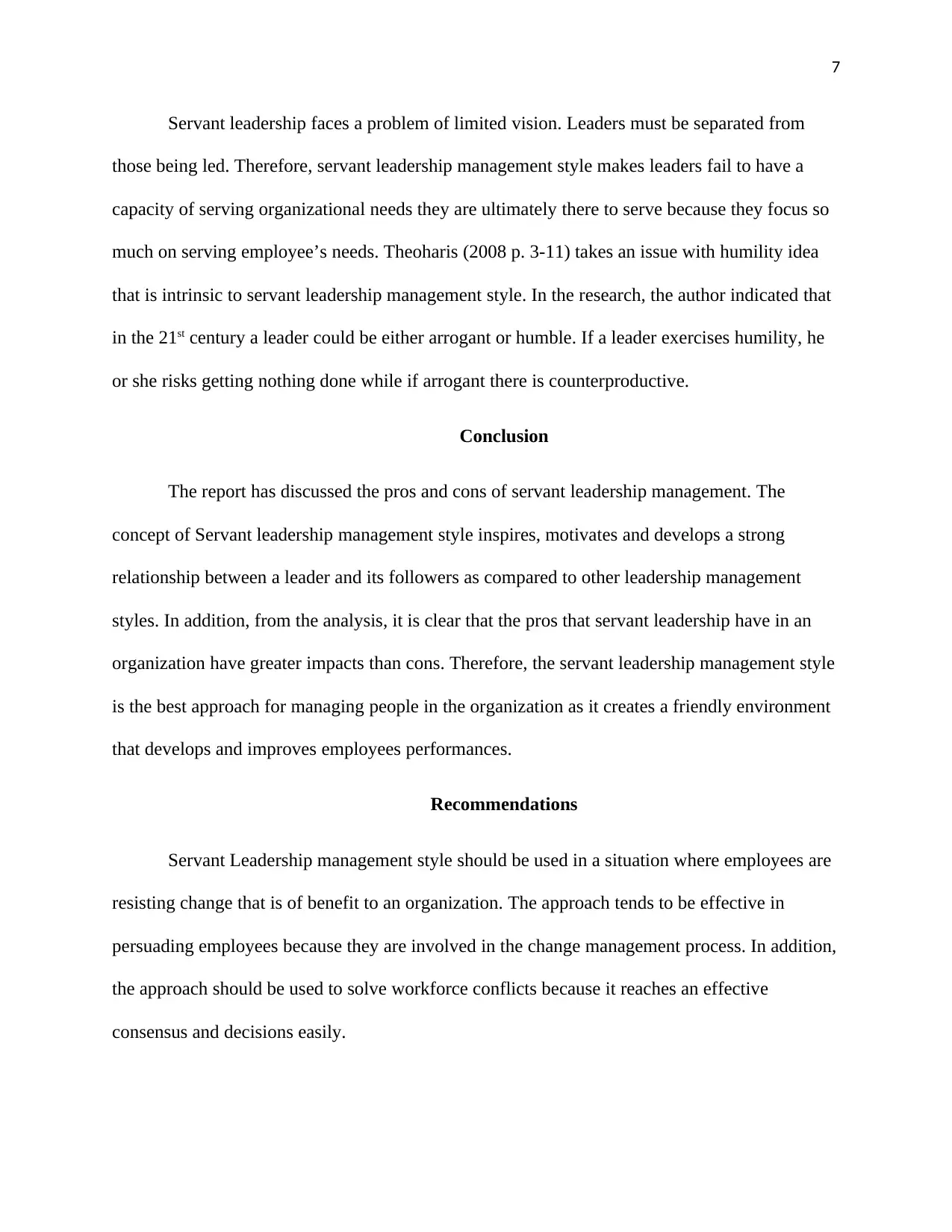
7
Servant leadership faces a problem of limited vision. Leaders must be separated from
those being led. Therefore, servant leadership management style makes leaders fail to have a
capacity of serving organizational needs they are ultimately there to serve because they focus so
much on serving employee’s needs. Theoharis (2008 p. 3-11) takes an issue with humility idea
that is intrinsic to servant leadership management style. In the research, the author indicated that
in the 21st century a leader could be either arrogant or humble. If a leader exercises humility, he
or she risks getting nothing done while if arrogant there is counterproductive.
Conclusion
The report has discussed the pros and cons of servant leadership management. The
concept of Servant leadership management style inspires, motivates and develops a strong
relationship between a leader and its followers as compared to other leadership management
styles. In addition, from the analysis, it is clear that the pros that servant leadership have in an
organization have greater impacts than cons. Therefore, the servant leadership management style
is the best approach for managing people in the organization as it creates a friendly environment
that develops and improves employees performances.
Recommendations
Servant Leadership management style should be used in a situation where employees are
resisting change that is of benefit to an organization. The approach tends to be effective in
persuading employees because they are involved in the change management process. In addition,
the approach should be used to solve workforce conflicts because it reaches an effective
consensus and decisions easily.
Servant leadership faces a problem of limited vision. Leaders must be separated from
those being led. Therefore, servant leadership management style makes leaders fail to have a
capacity of serving organizational needs they are ultimately there to serve because they focus so
much on serving employee’s needs. Theoharis (2008 p. 3-11) takes an issue with humility idea
that is intrinsic to servant leadership management style. In the research, the author indicated that
in the 21st century a leader could be either arrogant or humble. If a leader exercises humility, he
or she risks getting nothing done while if arrogant there is counterproductive.
Conclusion
The report has discussed the pros and cons of servant leadership management. The
concept of Servant leadership management style inspires, motivates and develops a strong
relationship between a leader and its followers as compared to other leadership management
styles. In addition, from the analysis, it is clear that the pros that servant leadership have in an
organization have greater impacts than cons. Therefore, the servant leadership management style
is the best approach for managing people in the organization as it creates a friendly environment
that develops and improves employees performances.
Recommendations
Servant Leadership management style should be used in a situation where employees are
resisting change that is of benefit to an organization. The approach tends to be effective in
persuading employees because they are involved in the change management process. In addition,
the approach should be used to solve workforce conflicts because it reaches an effective
consensus and decisions easily.
Paraphrase This Document
Need a fresh take? Get an instant paraphrase of this document with our AI Paraphraser
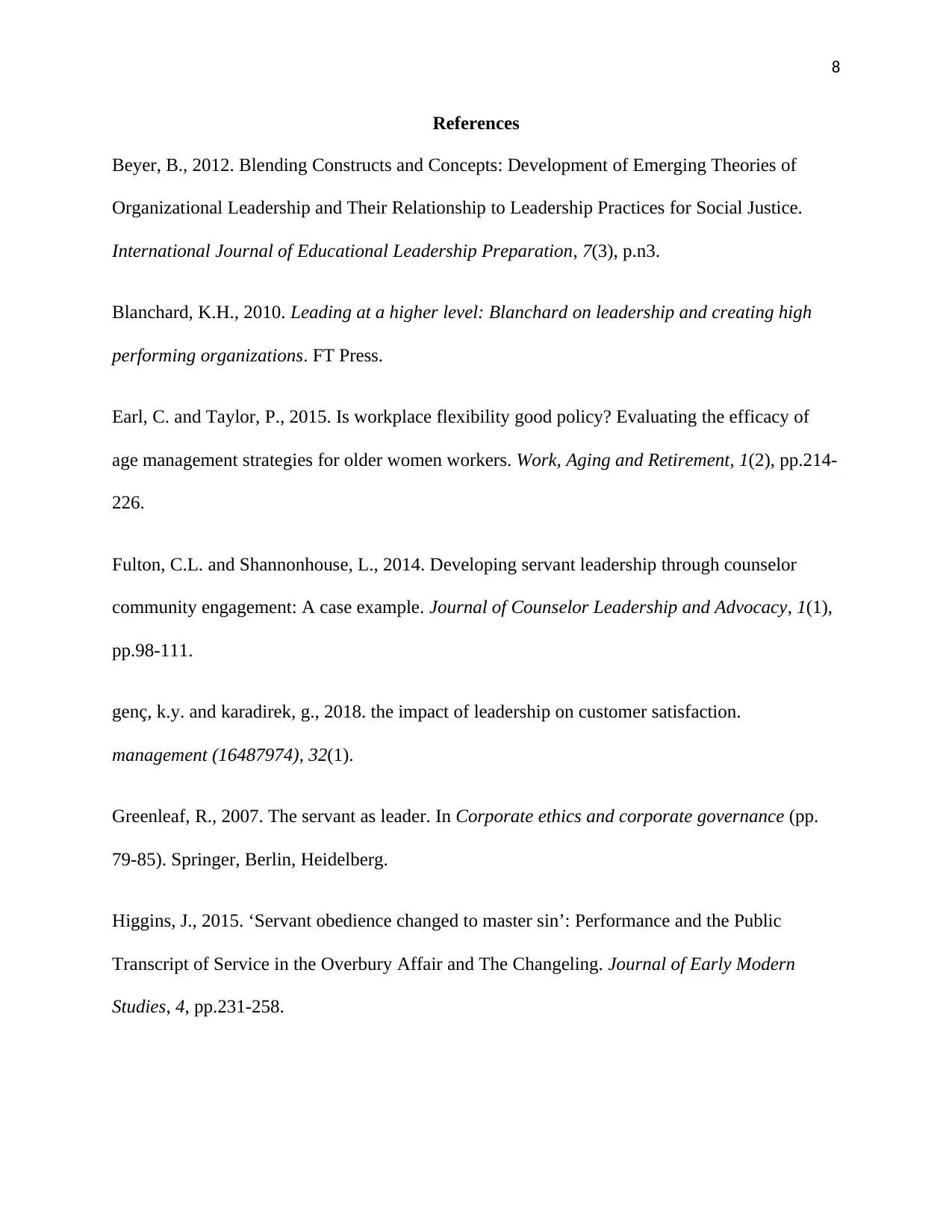
8
References
Beyer, B., 2012. Blending Constructs and Concepts: Development of Emerging Theories of
Organizational Leadership and Their Relationship to Leadership Practices for Social Justice.
International Journal of Educational Leadership Preparation, 7(3), p.n3.
Blanchard, K.H., 2010. Leading at a higher level: Blanchard on leadership and creating high
performing organizations. FT Press.
Earl, C. and Taylor, P., 2015. Is workplace flexibility good policy? Evaluating the efficacy of
age management strategies for older women workers. Work, Aging and Retirement, 1(2), pp.214-
226.
Fulton, C.L. and Shannonhouse, L., 2014. Developing servant leadership through counselor
community engagement: A case example. Journal of Counselor Leadership and Advocacy, 1(1),
pp.98-111.
genç, k.y. and karadirek, g., 2018. the impact of leadership on customer satisfaction.
management (16487974), 32(1).
Greenleaf, R., 2007. The servant as leader. In Corporate ethics and corporate governance (pp.
79-85). Springer, Berlin, Heidelberg.
Higgins, J., 2015. ‘Servant obedience changed to master sin’: Performance and the Public
Transcript of Service in the Overbury Affair and The Changeling. Journal of Early Modern
Studies, 4, pp.231-258.
References
Beyer, B., 2012. Blending Constructs and Concepts: Development of Emerging Theories of
Organizational Leadership and Their Relationship to Leadership Practices for Social Justice.
International Journal of Educational Leadership Preparation, 7(3), p.n3.
Blanchard, K.H., 2010. Leading at a higher level: Blanchard on leadership and creating high
performing organizations. FT Press.
Earl, C. and Taylor, P., 2015. Is workplace flexibility good policy? Evaluating the efficacy of
age management strategies for older women workers. Work, Aging and Retirement, 1(2), pp.214-
226.
Fulton, C.L. and Shannonhouse, L., 2014. Developing servant leadership through counselor
community engagement: A case example. Journal of Counselor Leadership and Advocacy, 1(1),
pp.98-111.
genç, k.y. and karadirek, g., 2018. the impact of leadership on customer satisfaction.
management (16487974), 32(1).
Greenleaf, R., 2007. The servant as leader. In Corporate ethics and corporate governance (pp.
79-85). Springer, Berlin, Heidelberg.
Higgins, J., 2015. ‘Servant obedience changed to master sin’: Performance and the Public
Transcript of Service in the Overbury Affair and The Changeling. Journal of Early Modern
Studies, 4, pp.231-258.
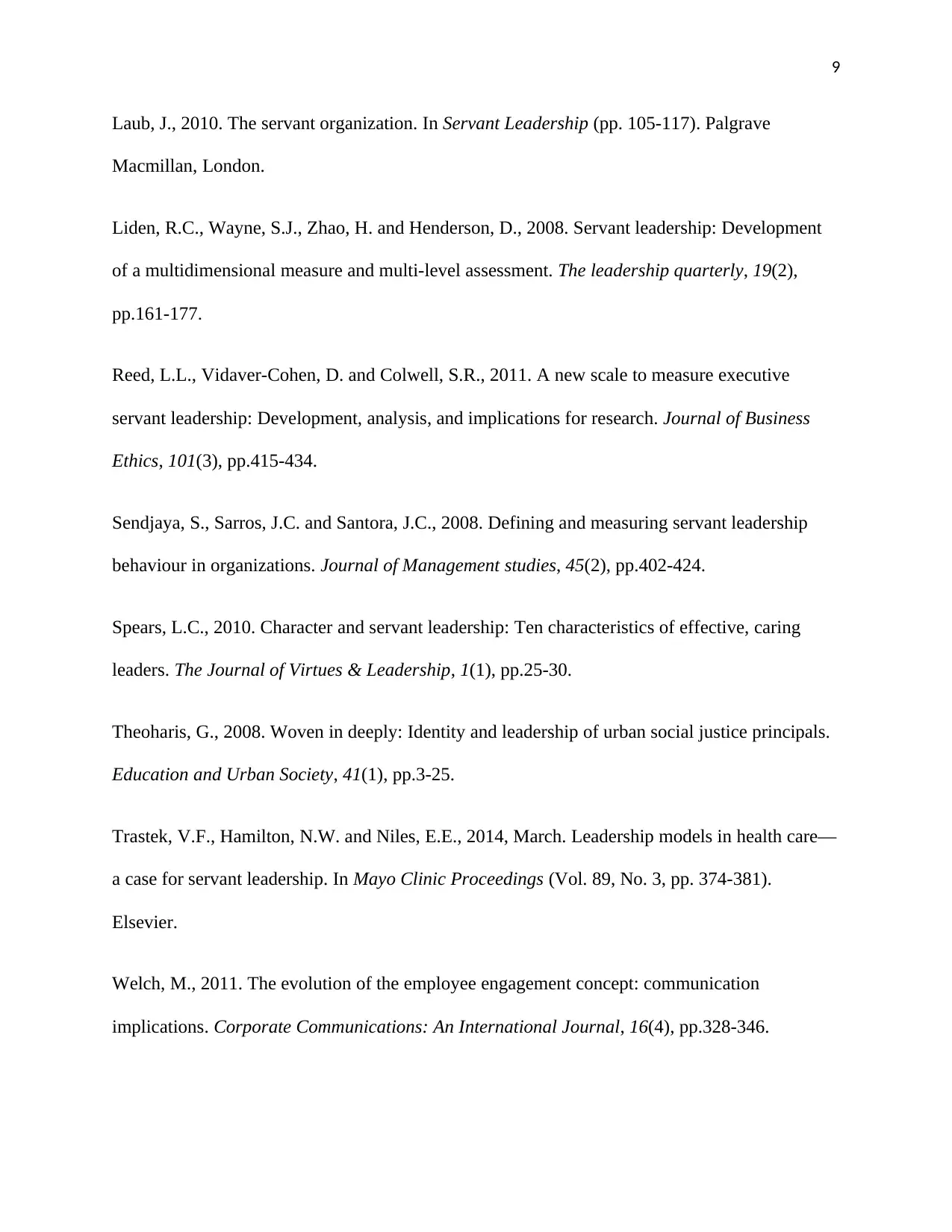
9
Laub, J., 2010. The servant organization. In Servant Leadership (pp. 105-117). Palgrave
Macmillan, London.
Liden, R.C., Wayne, S.J., Zhao, H. and Henderson, D., 2008. Servant leadership: Development
of a multidimensional measure and multi-level assessment. The leadership quarterly, 19(2),
pp.161-177.
Reed, L.L., Vidaver-Cohen, D. and Colwell, S.R., 2011. A new scale to measure executive
servant leadership: Development, analysis, and implications for research. Journal of Business
Ethics, 101(3), pp.415-434.
Sendjaya, S., Sarros, J.C. and Santora, J.C., 2008. Defining and measuring servant leadership
behaviour in organizations. Journal of Management studies, 45(2), pp.402-424.
Spears, L.C., 2010. Character and servant leadership: Ten characteristics of effective, caring
leaders. The Journal of Virtues & Leadership, 1(1), pp.25-30.
Theoharis, G., 2008. Woven in deeply: Identity and leadership of urban social justice principals.
Education and Urban Society, 41(1), pp.3-25.
Trastek, V.F., Hamilton, N.W. and Niles, E.E., 2014, March. Leadership models in health care—
a case for servant leadership. In Mayo Clinic Proceedings (Vol. 89, No. 3, pp. 374-381).
Elsevier.
Welch, M., 2011. The evolution of the employee engagement concept: communication
implications. Corporate Communications: An International Journal, 16(4), pp.328-346.
Laub, J., 2010. The servant organization. In Servant Leadership (pp. 105-117). Palgrave
Macmillan, London.
Liden, R.C., Wayne, S.J., Zhao, H. and Henderson, D., 2008. Servant leadership: Development
of a multidimensional measure and multi-level assessment. The leadership quarterly, 19(2),
pp.161-177.
Reed, L.L., Vidaver-Cohen, D. and Colwell, S.R., 2011. A new scale to measure executive
servant leadership: Development, analysis, and implications for research. Journal of Business
Ethics, 101(3), pp.415-434.
Sendjaya, S., Sarros, J.C. and Santora, J.C., 2008. Defining and measuring servant leadership
behaviour in organizations. Journal of Management studies, 45(2), pp.402-424.
Spears, L.C., 2010. Character and servant leadership: Ten characteristics of effective, caring
leaders. The Journal of Virtues & Leadership, 1(1), pp.25-30.
Theoharis, G., 2008. Woven in deeply: Identity and leadership of urban social justice principals.
Education and Urban Society, 41(1), pp.3-25.
Trastek, V.F., Hamilton, N.W. and Niles, E.E., 2014, March. Leadership models in health care—
a case for servant leadership. In Mayo Clinic Proceedings (Vol. 89, No. 3, pp. 374-381).
Elsevier.
Welch, M., 2011. The evolution of the employee engagement concept: communication
implications. Corporate Communications: An International Journal, 16(4), pp.328-346.
⊘ This is a preview!⊘
Do you want full access?
Subscribe today to unlock all pages.

Trusted by 1+ million students worldwide
1 out of 9
Related Documents
Your All-in-One AI-Powered Toolkit for Academic Success.
+13062052269
info@desklib.com
Available 24*7 on WhatsApp / Email
![[object Object]](/_next/static/media/star-bottom.7253800d.svg)
Unlock your academic potential
Copyright © 2020–2025 A2Z Services. All Rights Reserved. Developed and managed by ZUCOL.



